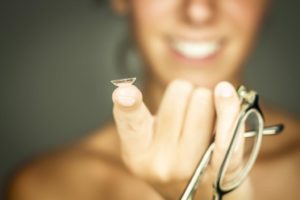 Today’s contact lenses offer better comfort and clarity than ever. As a result they are a vision correction option for more people, even those who may have tried contacts in the past without success. Whether you are near-sighted, far-sighted, young, old, or somewhere in between there is likely a contact lens option that will fit your needs.
Today’s contact lenses offer better comfort and clarity than ever. As a result they are a vision correction option for more people, even those who may have tried contacts in the past without success. Whether you are near-sighted, far-sighted, young, old, or somewhere in between there is likely a contact lens option that will fit your needs.
Contact lenses have been around for longer than most people realize. The concept for contact lenses was actually first presented in sketches by Leonardo da Vinci way back in the early 1500’s. It wasn’t until the early 1800’s though that a British astronomer by the name of John Herschel began producing molds of the human eye that would eventually lead to the first contact lenses being produced out of glass. These glass lenses fit over the entire eyeball and likely left much to be desired in the area of comfort. Finally, in the early-mid 1900’s a smaller, lighter lens made of a combination of glass and plastic was developed. This lens eventually evolved into the hard gas-permeable lens some of you may be familiar with, and then finally into the soft lenses most know of today.
Rigid Gas-Permeable (Hard or RGP) Contact Lenses
These lenses were the contact lens of choice from the 1950’s to late 1970’s. They provided excellent clarity of vision, relatively good comfort, and could be worn all day by most without any risk of infection or damage to the eye. In the late 70’s and early 80’s though, the “soft” contact lens began to gain in popularity. These lenses were more comfortable initially and thus easier to adapt to than RGPs. Even though the clarity of vision is actually much better with RGPs the convenience offered by soft lenses eventually led to them taking over the market. Today RGPs are only worn by a small fraction of contact lens wearers, usually just those who have to wear them due to a medical condition of the eye (which we will discuss later).
“Soft” Contact Lenses (Hydrogel or Silicone Hydrogel)
By the late 1980’s the soft (hydrogel) contact lens was becoming far more popular than it’s hard RGP predecessor. People were more than willing to sacrifice the excellent clarity of the RGP for the comparative comfort of the hydrogel lens, and doctors were more than willing to prescribe them because they were much easier to fit on the patients eye than RGP lenses. Eventually in the late 90’s an updated version of the soft lens was introduced called the silicone-hydrogel. These lenses offer even better comfort and have better oxygen permeability which is important for maintaining the health of the eyes.
Eye Infections Related to Contact Lens Wear
The big drawback of soft lenses, other than the somewhat poorer optics compared to RGPs, is the negative effect they can have on the health of the eye. Wearing the lenses too long, not cleaning them properly, or sleeping in them can lead to a serious eye infection known as a “bacterial corneal ulcer”. These ulcers can be very painful, cause severe light sensitivity, and even after healing can lead to severe scarring that permanently decreases vision. This is why taking proper care of contacts, changing them at recommended intervals, and avoiding sleeping with them is so important. Even though certain types of contact lenses are “approved” for overnight wear, sleeping in them can still greatly increase the risk of a serious infection.
Multifocal Lenses
Unfortunately, at a certain point we all develop a condition called presbyopia. This usually occurs around 40-50 years old and affects our ability to focus on things up close. In the past those with presbyopia who wore contacts for better distance vision would still need to wear reading glasses for near. Over the past several years though the quality and clarity of a type of contact lens called a multifocal have improved significantly. These lenses allow most people with presbyopia to see up close without the need for readers.
Daily Disposable Lenses
The latest trend in contact lenses is the daily disposable contact lens. The original soft contact lenses were designed to last a year or so with proper cleaning, which obviously presented some hygiene problems. Then in the 90’s monthly disposable and 2 week disposable lenses became more common. While those modalities are still popular, the best lenses today for comfort and eye health are daily disposables. These lenses are only worn one day and then thrown away. They provide excellent comfort since you are getting a new fresh lens every single day. They also make it less likely you will be tempted to sleep in them since there is no cleaning involved, they can just be taken out and tossed. Daily disposables are a great option for everyone, but especially kids since parents don’t need to rely on them to clean their lenses properly every evening.
Contact Lenses for Treatment of Medical Eye Conditions and Diseases
Contact lenses are also used in different ways to treat a variety of diseases or disorders of the eye. In particular, some people have a condition called keratoconus where the cornea (front surface of the eye) is irregularly shaped. Rarely after LASIK surgery some will develop an irregularly shaped cornea as well. These people usually cannot achieve good vision with glasses or even soft contacts, but are able to see well again with RGP lenses. In addition to treating irregular corneas, recent evidence indicates that multifocal lenses may actually help slow the progression of near-sightedness in children. And contacts aren’t just used for clearer vision anymore. They can also be used as bandages for abrasions (scratches) on the eye. They can be used to deliver medicines or treatments like amniotic membranes that promote healing of injuries and infections of the eye. Soon there will be lenses that can measure glucose levels in diabetics and measure eye pressure in glaucoma patients. There have even been patents filed for contact lenses that eventually record video and connect wirelessly to your smart phone. Seriously.
As you can see contact lenses have a lot to offer for a lot of different people. So whether you’re wanting to try contacts for the first time, you’ve tried them before without much luck, or if you currently wear them but want to see if there is something better out there, come see us at Metrolina Eye Associates. We offer all the latest brands, lens technologies, and treatment options to give you the best of what contact lenses have to offer.



